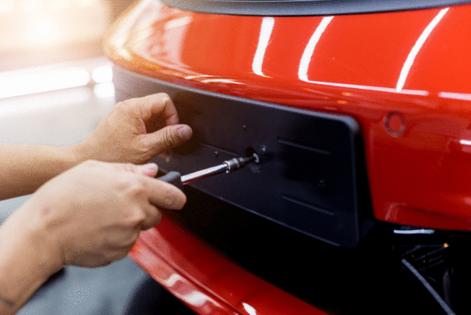Motormouth: License plate mounting
Published in Business News
Q: I recently purchased a 2026 Kia K5. The dealer mounted the from plate through a bracket and then drove the screw directly into the front bumper, creating two screw holes in the bumper itself. As soon as I realized this, (about two days after purchasing the car) I went back to the dealer to ask them about it. They insisted that it was standard practice to do so. I asked why didn’t they use a shorter screw with a nut to securely fasten the plate? Your thoughts please?
B.D., Medford, Massachusetts
A: That really seems to be standard procedure anymore. The bumper (actually, the bumper cover) is plastic and the screws hold rather well. But I agree that license plate screw kits with a push-in nut and stainless steel screws are the choice.
Q: As a 40-plus-year Toyota owner, I have a question about my latest vehicle. At my 20,000-mile checkup this spring, the tech told me that I needed to have my fuel injectors cleaned. I don’t recall ever having such a service with my previous vehicles. I drive only about 7,500 miles a year though I do use highways at least once a week. Is it normal to need fuel injectors cleaned with lower usage or is the dealer taking advantage of me?
E.B., Elmhurst, Illinois
A: Does your engine idle roughly? Has your fuel economy dropped? Have your car’s emissions gone up? Then you probably don’t need fuel injection cleaning. This is especially true if you use good gasoline or occasionally add some fuel system cleaner to the tank.
Q: I have a 2020 Toyota Highlander with tire pressure monitoring system. I have read the valve stem life is between four and six years before they begin to leak. I have had one leak so far. Is it possible to put in old reliable rubber valve stems? I realize I will lose the air pressure monitoring system, but a rubber valve does not usually fail after four years.
T.H., Olivia, Minnesota
A: Rubber tire valves have been reliable and around forever. But you don’t have to settle for a metal stem pressure sensor since there are rubber stem sensors available in the aftermarket.
Q: I have a 2024 Hyundai Tucson PHEV. At my 15,000-mile oil/filter/tire rotation appointment, the adviser talked me into a throttle body service, which I think is just a cleaning of the unit. I searched the web a bit, and most sites said don't waste your money until/unless there are issues with the engine running incorrectly. The adviser said Hyundai recommends the cleaning every 15,000 miles. I'm a retired senior and can't see myself paying a couple of hundred dollars every two years for this. Is this cleaning really necessary if the engine is running fine?
D.H., Cottage Grove, Minnesota
A: You are right. If everything is running smoothly, you probably don’t need a throttle body cleaning. But it may simply be wiped clean or can have an aerosol cleaner sprayed into it. I would keep my money in my pocket for now.
Q: I have always been told to change the oil every 6 months or 6,000 miles. I have a 2025 Honda CR-V Hybrid Touring model and am at 9,000 miles and 10 months. My maintenance minder says I still have 30% left. My mechanic says to believe the maintenance minder as it is tracking my driving. Is that true?
K.L., Chicago
A: Trust your mechanic.
©2025 Tribune Content Agency, LLC.












Comments